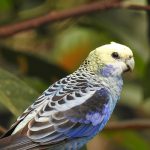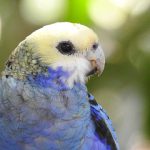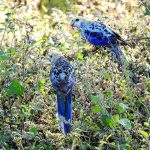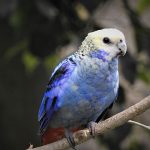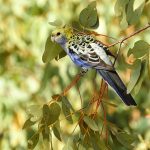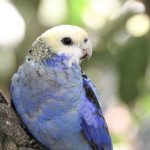PALE-HEADED ROSELLA
The Pale-headed Rosella is native to eastern Australia. It is a medium-sized parrot, measuring around 30 cm in length. They have a distinctive coloration, with a pale yellow head, white cheeks, and a red band across the forehead. The upperparts are dark green, while the underparts are yellowish-green. The wings display a mix of blue and black, and the tail feathers are blue with a reddish base. Adult males and females have similar appearances, but the females often have slightly duller colours.
These rosellas are primarily found in the coastal and sub-coastal regions of eastern Australia, including Queensland, New South Wales, and parts of Victoria where they inhabit various habitats such as eucalypt forests, woodlands, and open grasslands. They tend to favour areas near water sources, such as riverbanks and swamps.
Pale-headed Rosellas are social birds, found in small flocks or family groups. They are active during the day and are known for their acrobatic flying skills, mostly arboreal they spend time in trees and shrubs, where they feed on seeds, fruits, berries, blossoms, and occasionally insects. They use their strong bills to crack open seeds and extract the nutritious parts.
Breeding season for Pale-headed Rosellas typically occurs between August and January. They form monogamous pairs and construct their nests in tree hollows or crevices. The female lays a clutch of 4 to 6 eggs, which are incubated by both parents for about three weeks. After hatching, the chicks are cared for and fed by the parents until they fledge, which usually takes around 35 to 40 days.
Sadly these birds as many others face threats in the wild, including habitat loss due to land clearing and fragmentation. Additionally, competition for nesting sites with other bird species, as well as predation by introduced animals like feral cats and foxes, can impact their populations.
The Pale-headed Rosella is a beautiful and charismatic bird species native to Australia. Its vibrant plumage and presence add colour and charm to the natural landscapes it inhabits.
They can become accustomed to human presence and may visit bird feeders or be fed by people. However, it’s important to note that feeding wild birds is not recommended.


